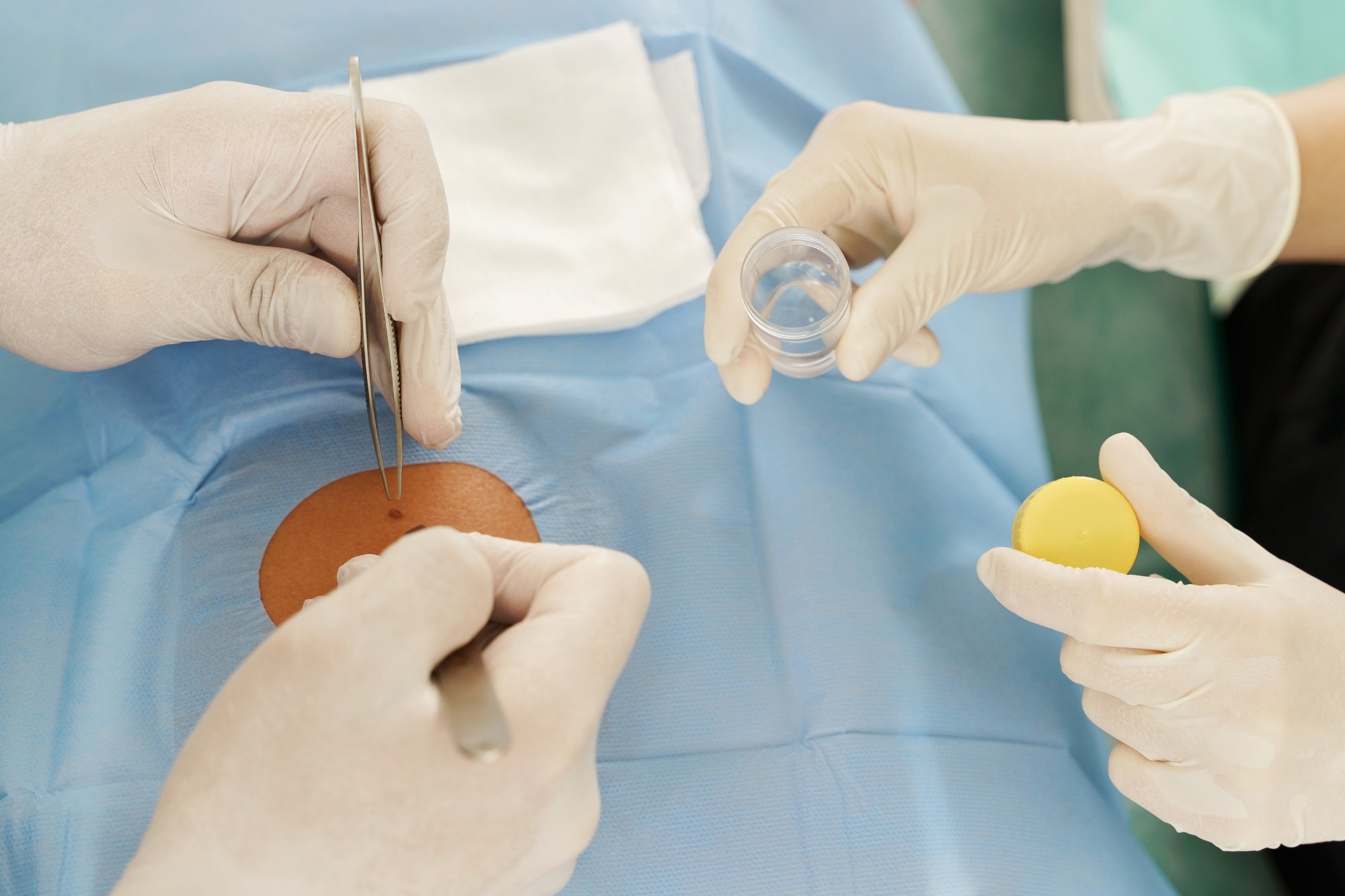In a recent study published in JAMA, researchers evaluated the positivity rate of cutaneous phosphorylated alpha-synuclein protein (P-SYN) deposition among individuals with dementia with Lewy body presence (DLB), Parkinson's disease (PD), pure autonomic failure (PAF), and multiple system atrophy (MSA).
 Study: Skin Biopsy Detection of Phosphorylated α-Synuclein in Patients With Synucleinopathies. Image Credit: BLACKDAY/Shutterstock.com
Study: Skin Biopsy Detection of Phosphorylated α-Synuclein in Patients With Synucleinopathies. Image Credit: BLACKDAY/Shutterstock.com
Background
Synucleinopathies are neurodegenerative illnesses that cause P-SYN accumulation in the peripheral and central nervous systems. They include PD, MSA, DLB, and PAF. These illnesses share clinical characteristics, including progressive impairment and neurodegeneration.
Current pharmacology lacks disease-modifying medication for these illnesses, and many individuals diagnosed with synucleinopathies face diagnostic delays or misdiagnoses.
A reliable biomarker for identifying synucleinopathies, such as immunohistochemistry of cutaneous phosphorylated α-synuclein, is urgently needed. This test might be sensitive and specific.
About the study
In the present prospective, multicenter, cross-sectional study, researchers investigated whether skin biopsy could detect P-SYN in PD, MSA, DLB, and PAF patients.
The researchers enrolled clinically confirmed cases of DLB, PD, PAF, or MSA recruited from 19 community-based and 11 academic neurology practices between February 2021 and March 2023, aged between 40 and 99 years.
Individuals without history or clinical features indicative of a synucleinopathy (such as constipation, hyposmia, dementia, rapid-eye movement [REM] sleep disorder, or mild cognitive impairments) or neurodegenerative disorders comprised the control group.
The researchers excluded individuals with biopsy-associated risks and synucleinopathy-mimicking diseases. They also excluded those with missing data from questionnaires and clinical examinations. The study exposure was a cutaneous biopsy for P-SYN detection.
The primary outcome was cutaneous P-SYN detection frequency among individuals with MSA, PD, PAF, or DLB and controls.
The researchers obtained skin biopsy specimens from the posterior cervical area, 3.0 cm from the spinous process of C-7, and the distal aspects of the leg at a distance of 10 cm from the lateral malleolus, and the thigh 10 cm from the lateral knee.
The team examined the participants using the Hoehn and Yahr scale, the Movement Disorders Society Unified PD Rating Scale (MDS-UPDRS), the Montreal Cognitive Assessment, and orthostatic blood pressure.
The participants filled out questionnaires such as the 39-component Parkinson's Disease Questionnaire, the European Quality of Life questionnaires (EQ-VAS and EQ-5D), the MSA Quality of Life assessment Questionnaire, the rapid eye movement (REM) sleep disorder questionnaire, and the Orthostatic Hypotension Questionnaire.
The researchers obtained disease symptom and duration data from participant medical records. The referral physician, who evaluated the individual, provided a clinical diagnosis.
The participant history, examination scores, medical records, and ancillary test results were transmitted to two disease specialists for central review to validate the diagnosis of the particular synucleinopathy based on specified consensus and eligibility criteria for diagnoses or controls.
Results
Out of 428 patients (277 with synucleinopathy and 151 controls), 343 were included in the primary analysis [mean age, 70 years; 175 (51%) men]; 223 fulfilled the consensus criteria for synucleinopathy, and 120 met the criterion as controls following expert panel evaluation.
Among those with synucleinopathy, 96 (28%) were diagnosed with Parkinson's disease, 50 (15%) with Lewy body dementia, 55 (16%) with multiple system atrophy, and 22 (6.4%) with complete autonomic failure.
The proportion of participants with P-SYN in their skin was 93% (n = 89) with Parkinson's disease, 98% (n=54) with multiple system atrophy, 96% (n=48) with Lewy body dementia, and 100% (n=22) with complete autonomic failure; 3.30% (n=4) of controls had cutaneous phosphorylated-SYN deposition.
P-SYN detection in the subepidermal plexus varied by synucleinopathy subtype, with MSA (49%, n=27) having a higher prevalence than Parkinson's disease (3.1%, n=3), DLB (10%, n=5), or PAF (9.1%, n=2). There were no infections or significant problems.
The length-dependent small fiber neuropathy varies amongst synucleinopathy subtypes. Neuropathy was most prevalent in DLB patients (78%, n=39), followed by those with Parkinson's disease (63%, n = 60), PAF (46%, n=10), and MSA (22%, n=12).
The overall P-SYN for all research participants corresponded with their exam results and surveys. P-SYN deposition by the study participants was associated with the period since MSA, PAF, and PD diagnosis.
Conclusions
The study findings showed that skin biopsy may identify phosphorylated alpha-synuclein among individuals with DLB, PD, PAF, and MSA. The findings demonstrated that cutaneous P-SYN in >92% of participants, with skin biopsies, was tolerated well with minor side effects.
However, there were 21% of misdiagnosed cases. Accurate diagnosis is critical for patient and family counseling, starting symptomatic treatment, and conducting clinical studies of possible disease-modifying medications.
Cognitive neurology experts recommend skin biopsy as a novel method for movement problems. The findings might speed up medication development for synucleinopathies by enhancing patient homogeneity in clinical trials.
More studies are needed to confirm the findings and better understand the potential relevance of skin biopsy detection in clinical treatment.
Journal reference:
-
Christopher H. Gibbons, MD, MMSc, et al., (2024) Skin Biopsy Detection of Phosphorylated α-Synuclein in Patients With Synucleinopathies, JAMA 2024, doi: 10.1001/jama.2024.0792.